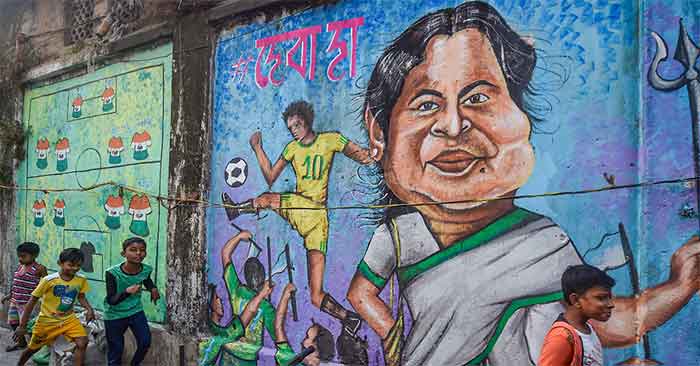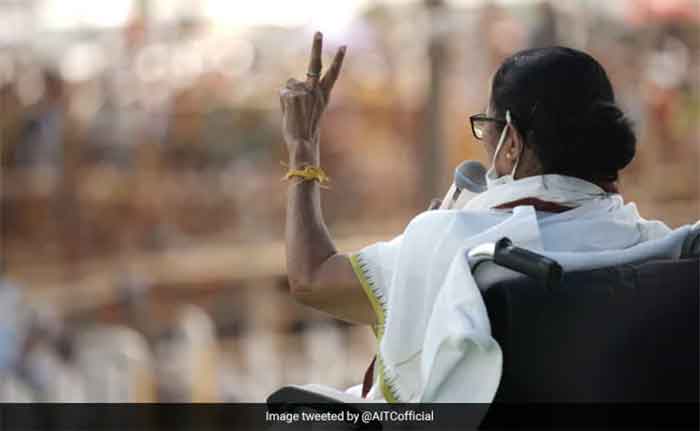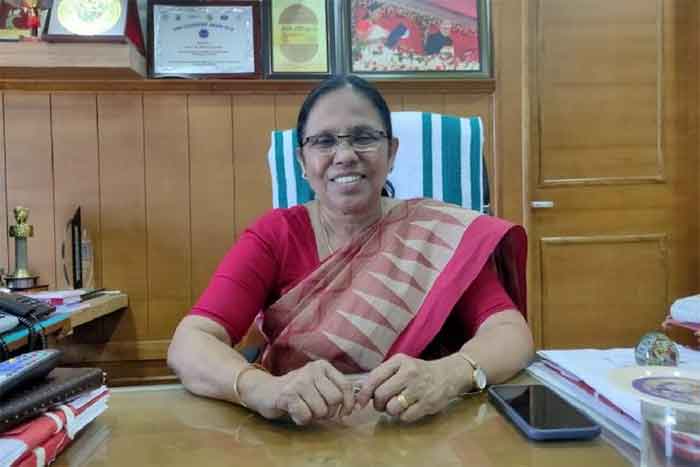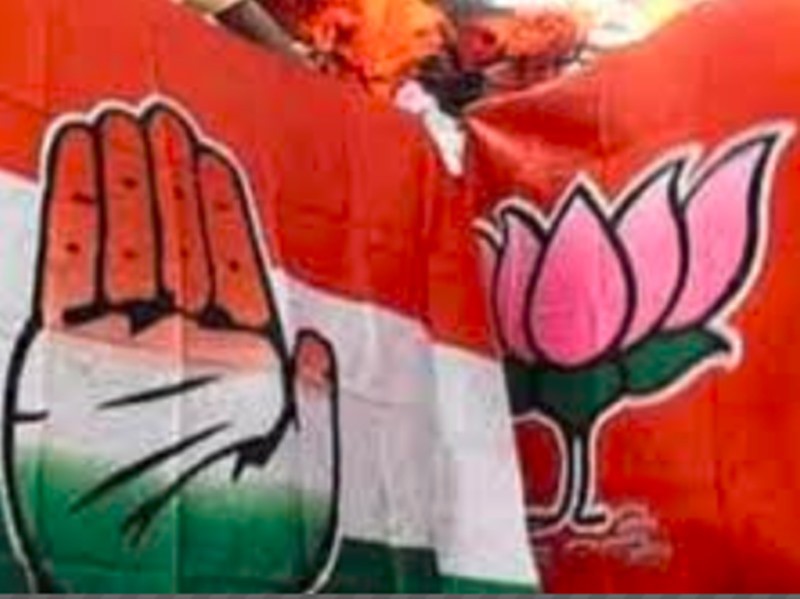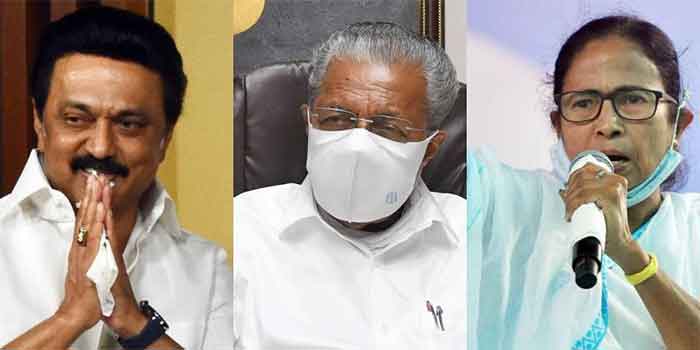
The results of five assembly elections are out. There was a lot at stake particularly for the ruling dispensation of RSS which made every effort to dislodge the West Bengal’s Trinamool Congress led by Mamata Banerjee. Bengal was Amit Shah’s lab from where he wanted to show why he matters most for the BJP. As we all know, Amit Shah did not campaign in the Bihar elections.
Bhadralok retains political monopoly
While it is good news that the Hindutva party despite its all efforts failed in Bengal but the fact is we need serious analysis whether Hindutva really got defeated or is the field wide open for it now with other opposition parties decimated in Bengal. Similarly in Assam the BJP has not been able to get a majority on its own but it manages to come back to power. The polarisation is clear. The BJP has been using communal polarisation for its own political gains but it is still a north Indian party and now under the Modi Shah regime, BJP is widely considered as Bania party with Gujarati interest. Nobody is more responsible for this than the two leaders who have not left a single impression without being a Gujarati biases. Whether it is appointment of officers in prime positions at the Central government or giving contract or favouring businessmen, it has been now clear to people of India that the current dispensation may have leaders from all castes but it actually represents the ‘interest’ of Banias. Brahmins are just playing subservient role in the current regime. Mamata realised this and hence she played the sub national card in which BJP got defeated. If you call BJP a Hindutva or Hindu party then the narrative suits it very well but if you call it a Brahmin Bania party of North India then there is chance that it would find difficult to counter the narrative.
I had always mentioned that Bengal was extremely suitable for BJP as the Bhadralok wanted unchallenged Brahmanical monopoly over the power structure. More than 35 years of left rule never brought the marginalised near to power structure and Brahmanical monopoly was establishing through ‘ideological’ mechanism of ‘caste does not exist in Bengal’. When the marginalised started questioning the whole narrative of the left forces, the same forces started looking for an alternative and Trinamool rose to power as Mamata Banerjee was not promising anything to Dalit OBC-Adivasis. She never even speaks about their participation. Bhadralok found in Mamata a leader who could continue their power and privileges. Over a period of time, there was resentment against Mamata and dissention among the marginalised related to their condition in Bengal. BJP had realised this very well and that is why Amit Shah focussed on the Matua community, which is the biggest among the Dalits in Bengal. The community is affected by the partition and crime against them by the fundamentalist groups in Bangladesh. It is they who were going to get a lot of benefit from whole process of CAA. Of course, the Hindutva party can never be pro Dalits so it fielded some of the outdated and overhyped ‘intellectuals’ such as Swapan Das Gupta, a man who no saner person can ever call a journalist or intellectuals. Many people were suggesting that he was a ‘chief ministerial’ candidate and Amit Shah has habit of appointing spineless chief ministers so that they can function as per the whims of fancies of the Central leadership. Except for Uttar Pradesh, most of the chief ministers of BJP ruled states are appointed from the top and have no personal charisma. In his over enthusiasm, Amit Shah played the Hindi card in Bengal and made a deep-rooted entry among them. The slogan ‘Jai Shri Ram’ was meant to instigate the lumpen crowds of North Indians living in Bengal. This actually boomeranged. We all know how Bangla nationality issue resulted in division of Pakistan in 1971 when Urdu was imposed on unwilling people of East Bengal. Modi and Amit Shah felt that Bengali Bhadralok will automatically come along with them as happened elsewhere but they were at fault. The Bhadralok realised well that Modi Shah’s Hindu nationalism is nothing beyond the interest of a few Gujarati Banias. It is this thought that Bangla people would have to live under the shadow of Hindi domination, that changed the mindset of the people to vote for TMC back. The Bhadralok also knew well that minority votes will go to TMC as they would not like to waste their vote as for them it is the biggest issue of their life. That is why parties like Congress got wiped out in their bastion of Malda region.
Mamata’s return is neither an empowerment of Muslims nor of Dalits. It is the retention of Bhadralok monopoly over Bengal politics. Is it not an irony that a state with over 24% of Dalits, 27% Muslims, 6 adivasis. It is interesting that though West Bengal government provide OBCs a reservation of 17% which include a majority of Muslims, it still has not been able to explain the exact number of OBC population in the state. Right from the days of the left parties, Bengal’s ‘progressive’ politicians have been in denial mode about the number of OBCs in the state. Mamata Banerjee put all the Muslim ‘castes’ in OBC category giving a handle to those who claim that it was bias and ‘appeasement’. The West Bengal government has provided 17% OBC quota without giving us a detailed explanation as how did it arrive at that figure.
In fighting against the devil, Muslims and Dalits had no other option than to switch over to Trinamool dumping Congress, left and their alliance partners. For Muslims, it has been a do a die battle after the CAA-NRC act passed by the parliament hence they voted it with great clarity. In nut shell, for Muslim it was a survival politics while for the Bhadralok it was a politics to retain power which they felt BJP can’t do it at the moment. But the danger is not disappeared. BJP still has over 38.8% vote share which and almost the entire opposition space in the Assembly with 77 seats as both left and Congress with their 9.3% vote share have just been able to get one seat. It need to be seen how things process in West Bengal but there is every chance that BJP would still try harder to play the communal polarisation but every crisis in Bengal is created to strengthen the Bhadralok hegemony and the Bahujan communities of the state have to just be tailenders of these parties. Bengal’s polarisation is nothing but management of Bengali Bhadralok to retain power and they have succeeded in it for years. This time too was no different.
Assam
The results from Assam also show that BJP and its allies have been able to polarise the voters as usual. Ofcourse, BJP on its own has not been able to get a majority. It is also a fact that BJP used the Congress Alliance with AIDUF to create a fear psychosis among the Hindus and Adivasis about the possible Muslim dominance. The fact that 31 Muslim Members have been elected for the Assembly, the highest since 1983 is a welcome sign. It is despicable to think how Hindutva party is determined to present strength our democracy as a threat to it. Muslims or any other non-Hindus are equal citizens of this country and have a right to get their person elected. It is always good that our political institutions reflect our diversity whether ethnic or religious. Assam also saw huge ‘management’ of voter list in the beginning and a large of people who are fighting for their citizenship rights, whose name have cropped under NRC were unable to vote. It is also a fact that bigger ‘regional’ issues are deliberately created to keep the upper caste hegemony and Assam is no exception to it. Unlike other states such as Manipur, Nagaland, Mizoram and Arunchal Pradesh where tribal leadership has emerged and has been leading though most of these states go along with the ruling party at the Centre. BJP has manipulated the politics in these states perfectly to suits its own interest. However, Assam is a big difficult state and BJP will find it difficult to run the government without satisfying different ethnic groups supporting it. We know it well that it will try to break smaller parties to manage comfortable majority. So far, the party has not been able to name a new chief minister.
Tamil Nadu, Kerala and Puducherry
Unlike West Bengal and Assam, where the polity is still dominated by the Hindu caste elite, Tamil Nadu, Kerala and Puducherry have seen the rise of backward communities in politics and the credit go to legendary EVR Periyar whose Dravidian cultural movement impacted the region. Puducherry is a very small state where Congress Chief Minister V Narayanasamy could not do much because of his continuous troubles with Lt Governor Kiran Bedi who was sent to this union territory to pave the way for BJP government. The Congress lost because these heavy weights were out of touch of the current reality. The new chief minister N Rangasamy has been the chief minister prior to Narayanasamy and has been known for his simplicity, easier access and honesty. He was a Congress member who fell to the internal politics of Congress party and then formed All India NR Congress. Congress’s top leadership was unable to take any corrective action there.
The Left Democratic Front government in Kerala was one of the best performers during the Covid period. Health Minister K.K.Shailaja became an international celebrity for her approach to Covid. The UDF was nowhere in picture and Rahul Gandhi’s efforts brought them into picture. UDF did not have a leader who could throw challenge to Chief Minister Pinyari Vijayan. Kerala normally see a shift in government in every five year but in elections we can’t take things for granted that way. The vote share of the Congress Party in Kerala was 25.1% while CPM had 25.4%. In terms of alliance wise vote share LDF has 45.81% and UDF has 38.39%. In terms of seats UDF won 99 seats out of total 140 in which NDA drew a blank.
Whatever is the result emerging from Kerala they give us hope that there is no space for the communal fanatic politics in the state. Second, alliances are historical in Kerala and well woven. UDF has issues of leadership while LDF was categorical under Pinyari Vijayan. One wish Kerla continue to switch between two big secular alliances. At the moment, a better party won and Pinyari Vijayan deserved a second term. It is also a fact that Communist parties in Kerala are different than their counterpart in West Bengal where the party remained hijacked by the Brahmanical Bhadrlok elite. Contrary to this, Pinyari Vijayan hail from Ezhava community and has faced lot of discriminatory and humiliating remarks by the right-wing fanatics owning to his caste occupation. Vijayan’s father was a toady tapper and he never hid that.
In Tamilnadu, DMK had already entered into an alliance mode and stitched it very well. AIDMK leader Jayalalitha’s death created a big void in the party. Secondly, as the party played subservient to Hindutva party in Delhi, DMK had the opportunity to collectively fight against the efforts to BJP to impose Hindi as well as Brahmanical north Indian culture on Tamilnadu state. BJP was nowhere in picture in Tamilnadu though it is definitely a well-known fact that Tamilnadu and Kerala is on their agenda but unlike West Bengal where all the mainstream parties never ever bothered about the marginalised communities, Tamilnadu has a history of social justice movement initiated by EVR Periyar. OBCs, Dalits and other communities are politically aware. It is the only state where total reservation is 69% as all the parties joined hand and supported the OBC quota.
With DMK, VCK, Congress and communist parties in alliance, it is one of the most power alliances and we hope it will function efficiently and provide a very pro people governance to Tamilnadu. Tamilnadu has a historical legacy of Dravidian movement and it will definitely reject all the overtures of the Hindutva party in the coming days too.
Lessons for the Congress and other opposition parties
There is a lot of talk about the anti NDA alliance after these state polls. Ms Mamata Banerjee too would be putting herself for a national alternative against Narendra Modi’s NDA which has been thoroughly discredited at the moment but there are a few factors that work for the BJP. A weakened Congress is not a good idea for countering the BJP and NDA. For the success of any coalition whether in states or at centre, we will require a pan India or pan state party around whom the alliance is weaved. As we have seen the two powerful alliances in Tamilnadu revolve around DMK and AIDMK. In West Bangal, the left front ruled with that power for 34 years. In Kerala the UDF revolve around Congress and LDF around CPIM. Alliances are important and need to be on a long-term basis. It is therefore important that Congress strengthen itself and become the centre of that alliance only then it will be a stronger alliance. Many people who are unknown to regional politics think that all the regional parties are pro Dalits-OBC which is wrong. Except for Tamilnadu, we don’t see any such trend of pro Dalit Pro OBC parties as most of them remain powerful because of their feudal caste relationship. It is therefore important that regional parties too must have an agenda of social justice. For Bihar, RJD has built a strong alliance so far and hope it remain long term. In Jharkhand too the alliance is powerful. For Uttar Pradesh, the crisis is much bigger as the two parties Samajwadi and BSP are at the logger heads and broke alliance after the last election. It is time to stitch an all-India alliance of parties who have a long-term programme to bring India into Constitutional path and focus on building health infrastructure, quality education for all, land reforms, implementation of reservation, strengthening the autonomy of the institutions, National Judicial Services. There can be other issues according to the regional preferences too.
Where does Congress go from here
The polls were a disaster for Congress party. It could not come back in Assam despite a power alliance with AIDUF. Though Party’s vote share is more than that of BJP yet party failed to perform well. Such was the lack of confidence of minorities with BJP that In West Bengal the party suffered because the minorities did not want to waste their vote. In Puducherry, the party paid a price with continuance of Narayanasamy as chief minister who was definitely an honest person but lost touch with people. In Tamilnadu, the party performed well in alliance with DMK and in Kerala its performance was far below.
While Rahul Gandhi should be appreciated for putting secularism, social justice and rule of law in Congress’s agenda and bringing back ideological issues in the party, he advisers still were focussing on his ‘brand building’ so the college visits, push ups or going to tea estates in Assam by Priyanka were well planned but in todays time just focussing on them will not work. It was important for Congress party to give an agenda through its political meetings which it failed. Rahul Gandhi still is paying a price for historic ‘legacy’ which the middle classes have forgotten. Congress’s drawback is that it does not have powerful regional leaders as most of them picked up by the high command are rootless and cant communicate with people. It is essential for Rahul Gandhi to not just focus on brand building but also on organisational set up as well as bringing powerful OBC and other non-brahmin communities in the party. It is important for the party to give charge to those leaders who can build organisational structure in the states.
Though Congress was an upper caste party and served their interests pretty wells, after Sonia Gandhi, the Sawarna Hindus have developed an aversion for it under the pretext of party’s’ support for reservation and minorities. Congress has not been forthcoming on these issues and hence was neither able to get support of the Sawarnas nor the Dalits.
Unfortunately, right from the Time of Devaraj Urs, who was the tallest leader of Karnataka belonging to OBC community, Congress countered it with Dalit-Savarna alliances. In the aftermath of Mandal revolution in India, Congress further damaged as Rajiv Gandhi had openly opposed it in Parliament. The party made no efforts to reach out to the OBCs. It rarely allowed strong OBC leadership and the result is today, it does not have strong regional satraps in Southern part while in North India OBC leadership emerged with their own parties while others join hand with BJP making Congress ineffective. In South, it already lost Reddys in Andhra after people felt ditched in the aftermath of YSR’s death when it hoisted K Rosaiyya as chief minister who was rootless. Andhra used to be Congress domain but after the Telangana fiasco and I am calling it so because Congress played so many games that it lost good will on both the sides. If it had implemented its plan properly, it should have gained in Telangana but today it does not exist in Telangana or Andhra which is extremely sad as BJP marching ahead in these states to occupy the opposition space. Similar thing is happening in Maharashtra where Maratha leadership is in the hands of Sharad Pawar and now with Shiv Sena in alliance, Congress will ultimately become redundant there with a few brahmin bania leaders who are without any basis.
Congress will have to look seriously on the issues of organisation as well as building up strong regional leaders from different communities particularly Dalit, OBCs, Adivasis and minorities. Congress also needs to strengthen its ideological and organisational basis where it is fighting against BJP. Unfortunately, right from Rajasthan, Haryana, Madhya Pradesh, Gujarat Congress leadership does not have any specific difference with the BJPs and that makes thing for Congress difficult. BJP has already captured imagination of the caste Hindus who are ready to forgive the party but if they are compelled to revolt against the BJP because of the absolute failure to handle Covid situation, then these savarnas will prefer the regional satraps who can protect their interest. Whether it is KCR or Mamata Banerjee or Arvind Kejriwal, the pro Sangh lobby will be happy to make them BJP’s alternative than the Congress. In the current scenario, revival of Congress is necessary for survival of constitutional democracy in India as we all know Congress neta’s are not from a different breed and that is why changes being brought by Rahul Gandhi had been resisted by the powerful Brahmanical lobby In the party.
In the longer term, DMK leader Stalin and Kerala Chief Minister Pinyari Vijayan along with other powerful OBC-SC-ST leaders need to join hand and bring hope in the lives of the people.
In the meantime, we can only say that results of the assembly elections have proved that India will have to learn to live with coalition politics and attempt to impose one language-one religion-one culture will only prove counterproductive. The only oneness in terms of unity and integrity of India is the supremacy of Constitution and rule of law otherwise all states have their unique local traditions which must be respected and allowed to flourish. Hindutva is defeated but it is not out and for that forces of social justice will have to join hand and work together to stop it.
GET COUNTERCURRENTS DAILY NEWSLETTER STRAIGHT TO YOUR INBOX

